When I talk to product teams and company leaders, one challenge comes up more than anything else: the mindset of the company. It seems that even in the 21st century many people feel that their companies are too top-down, sales-driven, output-focused, and traditional. This is a far-reaching problem. I see it in old businesses looking to transform, but also in Silicon Valley mega-companies, in unicron scale-ups, and even in startups. I’ll show you data that suggests that the bigger and older a company gets the more likely it is to slip into older ways of thinking and behaving—a risk many executive teams are aware of, but few manage to mitigate.
Why is this a problem? Because the mindset dictates behavior. It perpetuates the current ways of working and inhibits change. Modern approaches are either rejected as not applicable (“sure this works for Google, but it won’t work with our employees”), or subverted to match the company’s worldview. Agile Development becomes a way to boost engineering productivity, Objectives and Key Results (OKR) a method to enforce top-down decisions, and experiments, well they’re just a feel-good exercise that doesn’t change anything.
According to MIT professor Edgar Schein, the things we see on the surface—the structure of the organization and the processes it uses, are determined by inner principles and philosophies it employs, and those in turn are affected by unspoken core beliefs and assumptions. For example, a company that relies on yearly projections and roadmaps (process), is actually practicing the age-old strategy of plan-and-execute (principles and philosophies), which is based on the assumption that the future is predictable and plannable and that process can lead to the expected results (core beliefs). Good luck switching this company to use outcomes-based roadmaps without first changing its lower-level philosophies and beliefs.
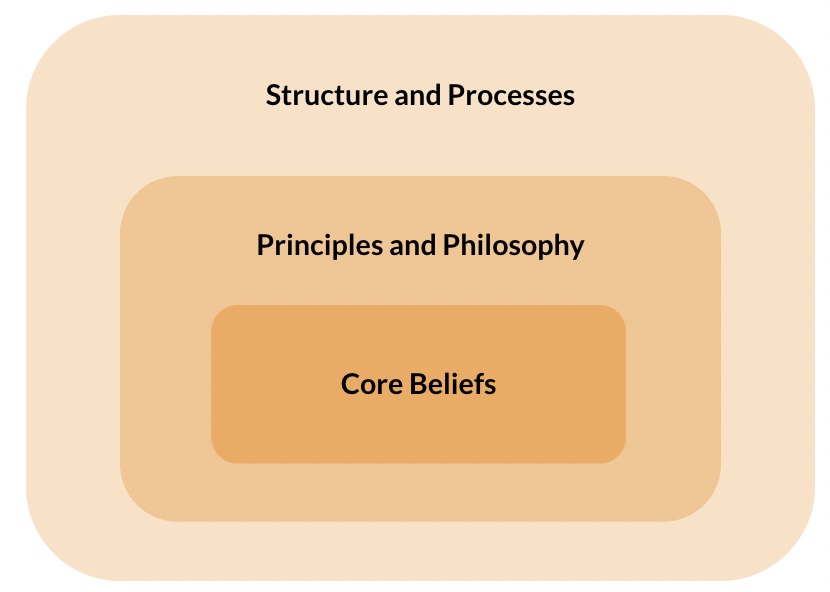
Mapping Core Beliefs
Exposing the the mindset is therefore an important first step. In my experience six core beliefs are most important in shaping the mindset:
- Business-focus vs. customer-focus – Traditional orgs believe that the core mission of the company is to grow its market share, revenue, and profit margins. The customers are of course important, but are perceived as assets to win over and to defend from competitors. Modern orgs care a lot about business success, but see it as bi-product of delivering high value to their customers. Value-delivery is therefore the primary goal of the company.
- Certainty vs. uncertainty – Traditional orgs hold on to a deterministic worldview where proper research, planning, and execution can lead to predictable results. Classic example: if two important customers ask for a feature then building this feature is sure to grow revenue. Modern orgs believe there’s too much uncertainty, complexity, and change to make reliable predictions. They therefore prefer to rely on discovery, evidence, and adaptive planning.
- Top-down management vs. empowerment– In the traditional model the manager decides what to do, and the reports choose how to do it (with approval and supervision). This is also known as command-and-control. Modern organizations see major risks in top-down management as it amasses power (and potential for massive errors) at the top, and disempowers employees. They strive to push decisions down to the right level. Some (although this is still a small minority) even try to replace the hierarchy altogether with a flat, self-governing org. Still, there’s no clear, agreed-upon, alternative to top-down management and almost all companies practice it to some level.
- The role of processes: predictability vs. adaptability — The traditional org sees itself as a machine, where each sub-system and each bolt has to perform optimally. It therefore tries to segment the company into clear departments, sub-departments and roles, and to define explicit processes and interfaces at every point. The role of the processes is to drive predictable behavior and to prevent errors and underperformance. The modern org sees itself as an organic system where imperfect people and teams have to collaborate in variable and somewhat unpredictable ways. Flexibility and adaptability are seen as the key to success. The org therefore tries to avoid prescriptive processes and instead puts in place general principles (for example Netflix’s Leading with Context, or Google’s Fail Fast.) It leaves the choice of process to the team and individual.
- Opinions vs. evidence – The traditional org has high trust in the opinions of leaders, experts, and committees. A modern org considered outside evidence the definitive source of truth that should supersede opinions when making decisions.
- Trust vs. mistrust in employees — In the traditional model the rank of an employee dictates how much the organization trusts it with responsibility and information. Rank-and-file employees are least trusted: they have to be guarded from making mistakes, and limited in what they know. A modern org is very trusting of its employees. Even junior members are exposed to sensitive information and are assumed to be reliable and smart enough to operate without much supervision.
Note 1: The terms traditional and modern are of course subjective — what’s radically new for one company may be old news for another. Still there is a meaning here. All the traditional beliefs can be traced back to classic management theory, developed in the first half of the 20th century by theorists such as Weber, Taylor and Fayol, in response to the industrial revolution. Modern beliefs stem from newer theories of management, psychology, sociology, economics, engineering, and design, developed in the second half of the 20th century, as the workforce became better educated and businesses more complex and information-based. These aren’t especially new theories (some date back 70 years), yet they seem surprisingly fresh, even radical, to many companies.
Note 2: This is far from being the only model of company mindset/culture. For reference see Erin Meyer’s Culture Map, Westrum’s Typology, and dozens more (for an overview, here’s John Cutler’s explanation). These models are likely far better researched than mine.
Sign up to my newsletter to get articles like this (plus eBooks, templates and other resources) in your inbox.
Using the Core Belief Model
The six beliefs are dimensions, rather than binary attributes, and every organization strikes its own balance on each. You can imagine the mindset as a control panel with six sliders:
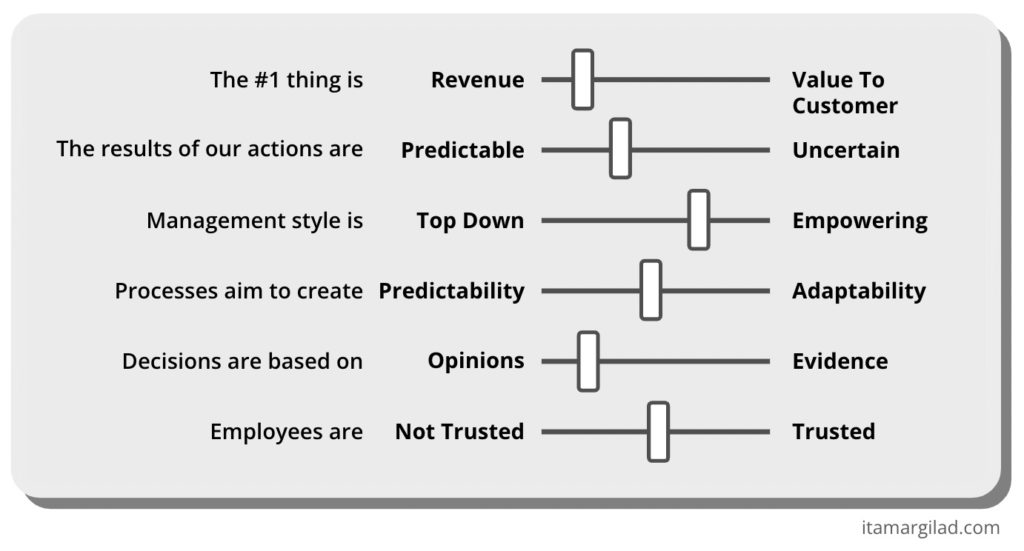
Personally I find this model very helpful as I try to help companies build better products and product organizations. Surfacing core beliefs is a good way to assess the state of the company and to detect what’s holding it back the most. Sometimes the model tells me to walk away — if too many sliders are too far to the left, I’m probably not the right coach for this company.
I can see the core belief model being used in other ways too:
- As you hold a retrospective, keep asking “why?” until you reach the core belief that’s the root cause, then consider if this belief is helpful or not.
- When you experience friction or frustration at work, mapping the core beliefs of your managers and colleagues (as well as your own) may point at the source of the problem.
- As you interview for a role in a new company or team, understanding its mindset may be as important as discussing compensation packages and responsibilities.
- Companies may try to regularly assess where they stand on the six dimensions (for example through anonymous employee surveys) and to discuss where they want to be.
Getting Data Behind The Model
As I mentioned above, this is not a rigorously researched model. It’s based on hundreds of discussions and thousands of experiences I had with people and companies of all sizes (predominantly in tech). I find it useful, but that just may reflect my own biases and beliefs.
To get a better sense of how other people think, I created this anonymous survey. It lets respondents rank their company on the six core beliefs and provide contextual data such as company size, age, and location, as well as their own rank and job satisfaction. I hope to see if there’s a correlation between any of these variables, and especially whether company size and age are determining factors of the mindset. I’m about to share with you some early results, some are surprising.
Obviously such a survey reflects people’s opinions, rather than hard facts. Still, in my experience what people say about a company is usually the best indicator of what it really is like (there aren’t many objective alternatives). That’s why companies conduct internal employee surveys, why Glassdoor exists, and why it’s good practice to talk to people on the inside before you join a company. I don’t put a lot of trust in any individual response, but I feel that in aggregate the results can be quite meaningful—the more answers we get the better.
My intention is to share the results publicly and to drive discussion. This may mean people may run their own internal company surveys — please share if you do — or even improve the model. I’d love this to be carried forward by the community.
Before I share the early results and bias you, I’d like to ask you to fill out the survey now. It only takes a couple of minutes and the survey is anonymous. You can also help by sharing this article broadly.
Wish to bring these concept to your company and team? Check out my Lean Product Management Workshops.
Early Results
Caveats:
- Small sample – at the moment I have around 200 survey responses, which is not enough to draw real conclusions, Please consider this a preview and treat all the results as unreliable. I promise to redo this analysis once I have more data.
- Reflects respondents’ opinions – I explain why I think that’s ok above.
- As in every survey, there may be biases introduced by sampling, by the phrasing of the questions, by the options provided, etc.
With the caveats out of the way, let’s look at the early results.
Normal Distribution, but with hints of split between predominantly modern and predominantly traditional companies (bi-modality)
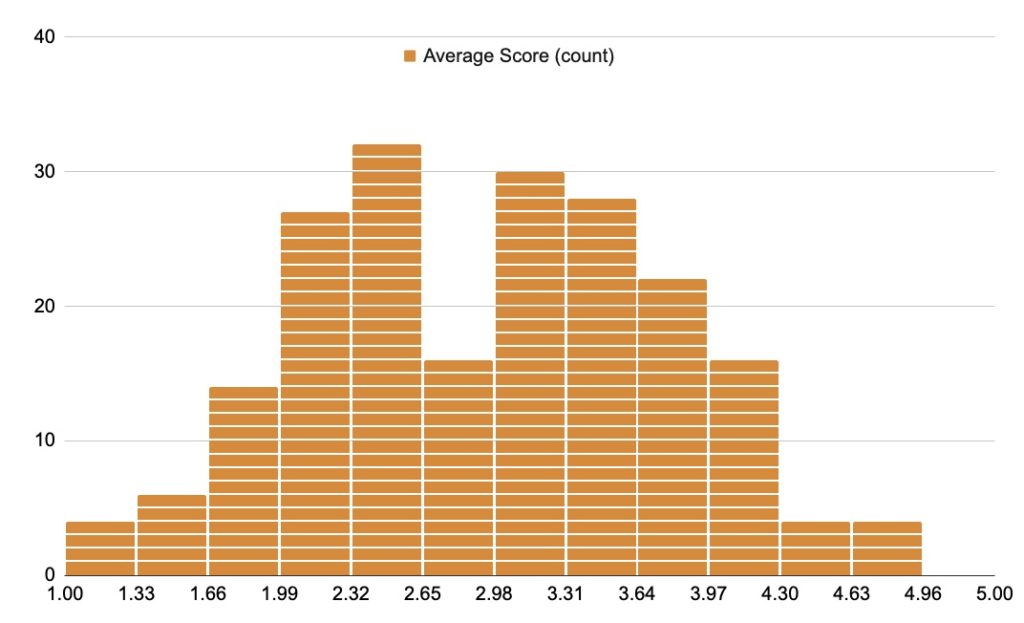
This is the distribution of average scores (averaging each response across the six dimensions). 1 reflects the most “traditional” beliefs and 5 the most “modern”. You can see a rudimentary normal distribution around the middle-point (3), but with an apparent gap, which may mean that this is a bimodal distribution (two peaks) rather than a normal one. We need more data to know for sure. The overall average score is 2.9 and the median is 3.0.
Here’s the distribution of each of the beliefs.
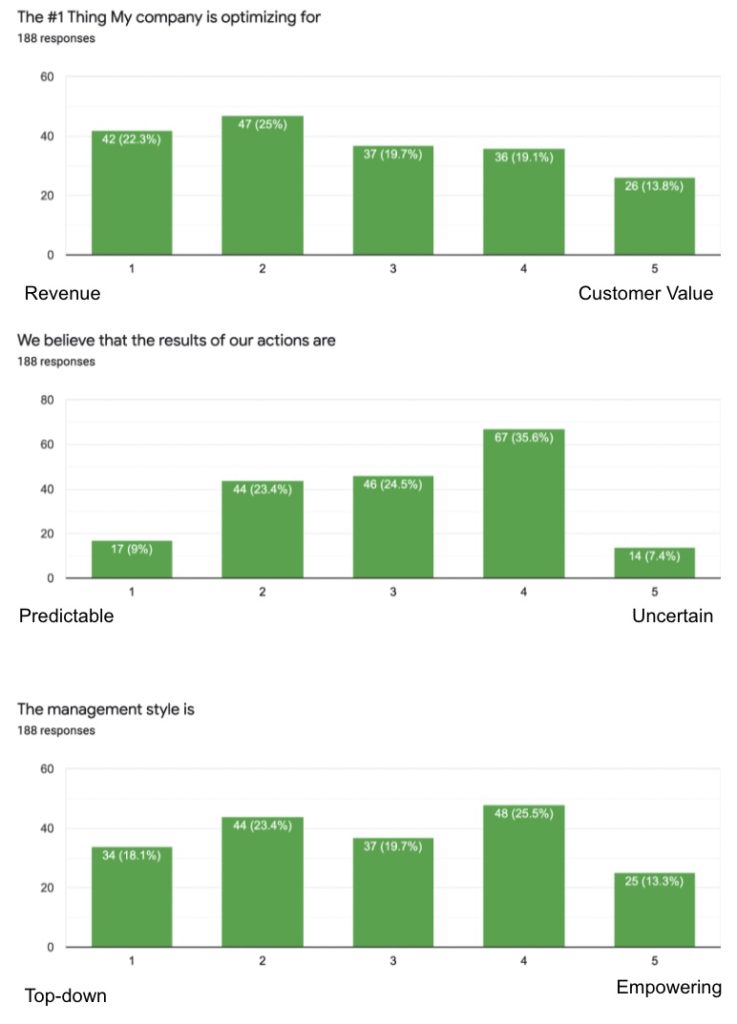

Some dimensions are normally distributed, but with a bias in one direction or the other. For example it seems that on average companies bias towards trusting employees, although not 100%. You can see that the results are much more split (bi-modal distribution) on the dimensions of decision making, role of processes, and management style. This may mean there are two classes of companies with different attitudes.
Clear Correlation Between Mindset and Age
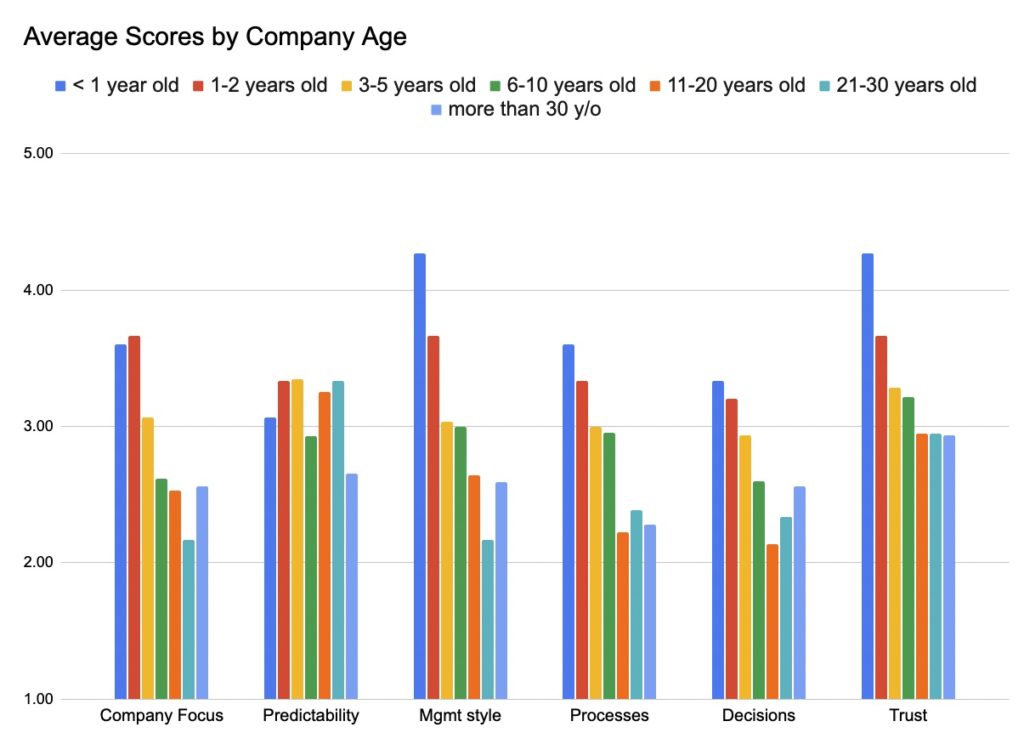
According to these early results, in every dimension (except predictability), the younger the company is the more likely it is to display a modern mindset. If this is true, if you want your company to be customer-focused, evidence-based, and empowering, your best bet is to join a startup. The odds of these things happening drop sharply if your company is older than 10.
Here are two examples where age creates a massive difference (the charts show the distribution of values, with 1 [blue] being the most traditional and 5 [red] most modern):
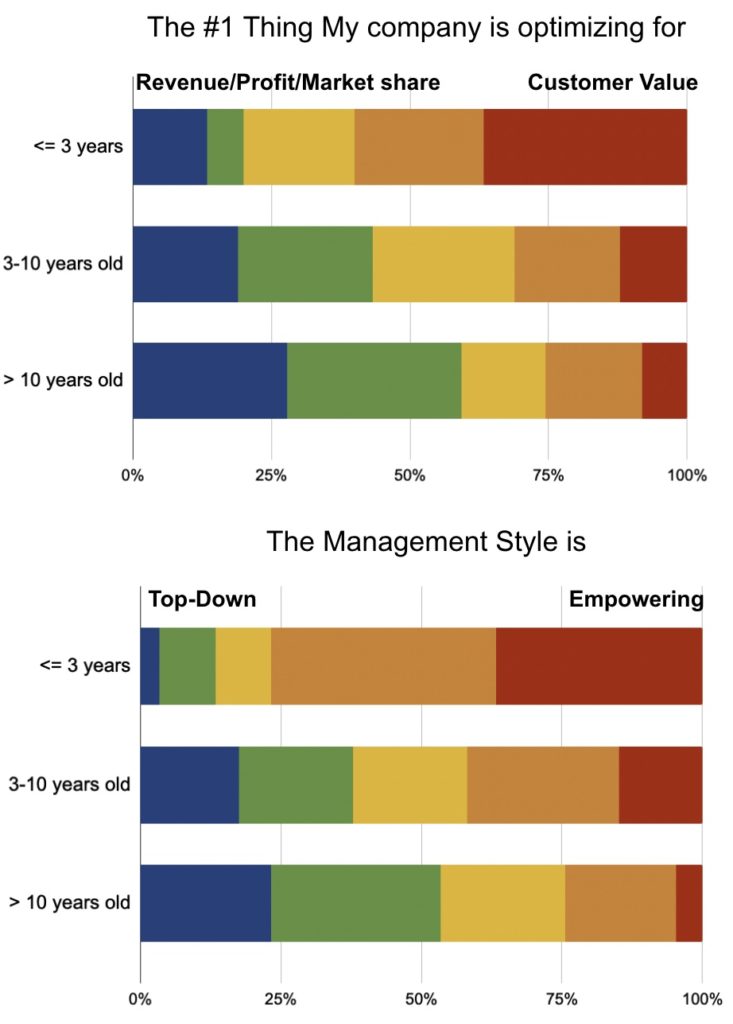
There might be a number of explanations for this pattern (if true):
- Companies start with a modern mindset, but move to a more traditional one as they age.
- Companies start out with the beliefs that were considered modern at the time, but don’t evolve their mindset over the years.
- Employees in younger companies may perceive their companies more “modern” compared to employees in older companies (perhaps due to having less experience).
Mindset is correlated with company size, but to a lesser degree than age
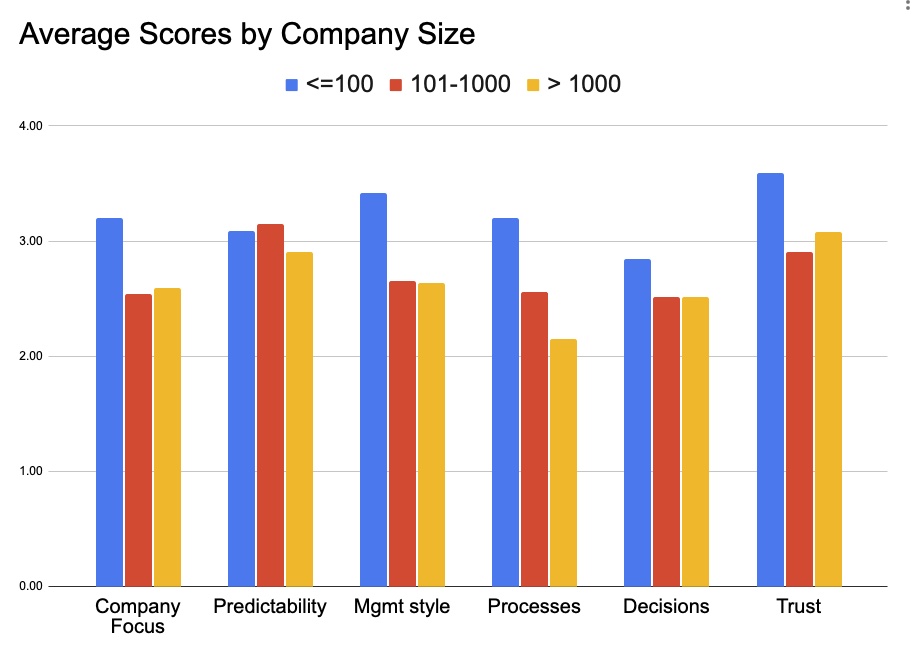
I expected company size to be the most important predictor of mindset, but it seems to be less so compared to age. According to this early data, small companies are much more likely to have a modern mindset than older ones, but there’s not much of a difference between medium-sized companies and large organizations. One explanation might be that there’s a mix of old and young among medium and large companies, and as we saw, age has a strong correlation to mindset.
The one factor that is strongly correlated with company size is the role of processes. which clearly shifts towards focusing on predictability rather than adaptability.
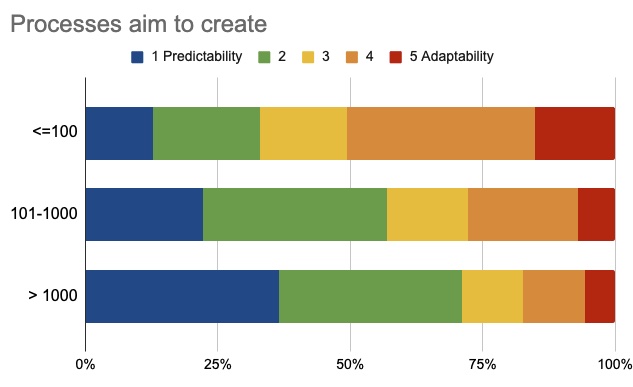
On the other hand, opinions seem to weigh heavy in companies of all sizes:
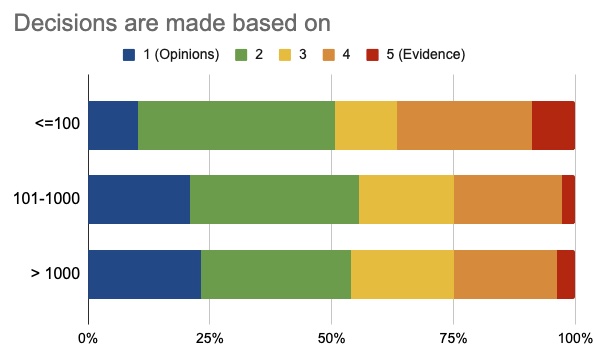
North America vs. Europe
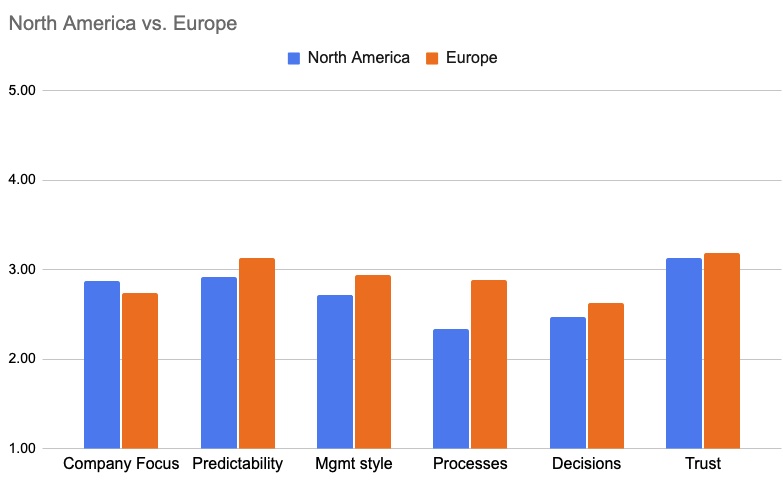
Like most people, I thought that European companies are more traditional and conservative compared to their north-American (USA and Canada) counterparts, but the early data suggests otherwise. On average, people working in European companies report them to be slightly more modern on most factors.
The most striking difference is in the approach to processes:
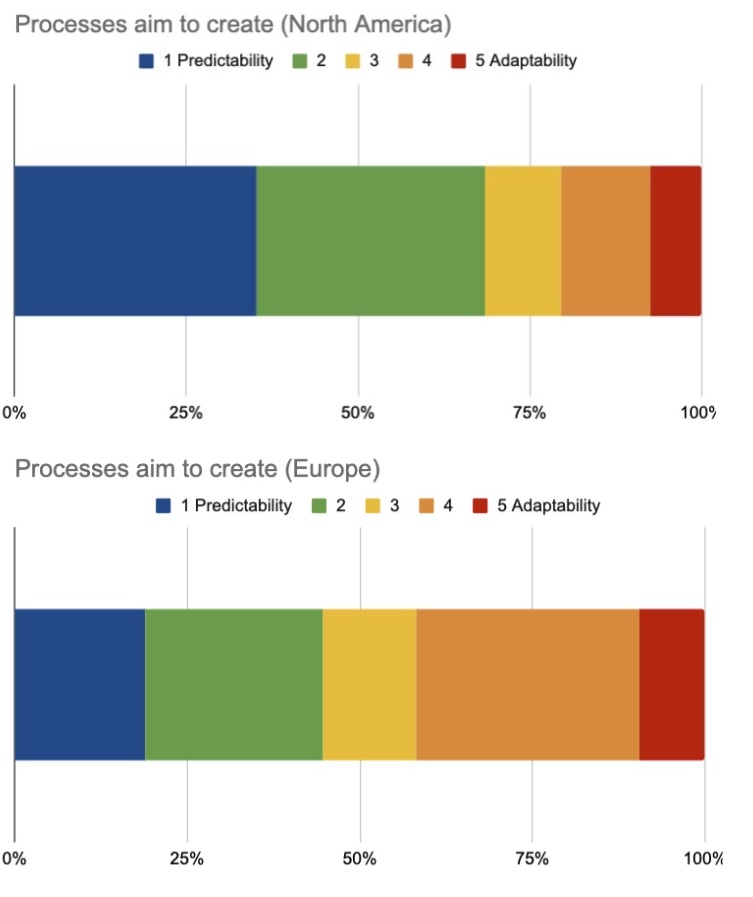
I’m somewhat suspicious of these results. This may be an artifact of having a smaller sample of NA companies (if you’re from the USA or Canada you know what to do). When I shared these results with John Cutler he suggested another hypothesis: North Americans may expect more modernity and thus judge their companies as too traditional, while Europeans have a different frame of reference. I’m really interested to hear what people from both regions think of this matter.
I’d also love to run this analysis for other parts of the world, but I require more data — please fill out the survey if you wish to see your part of the world reflected in the analysis.
Next Steps
There are many other questions I’d like to explore with the Core Belief Model. For example, are people working for more modern companies generally more satisfied? Does the mindset affect how successful the company is at achieving its goals? Does seniority affect how we perceive our companies?
I don’t have enough data to say anything definitive about any of these, although I have my theories.
How you can help:
- If you haven’t already, fill out the survey
- Share this article with friends and colleagues, ideally also in other companies / geographies to foster diversity.
- Tell me what you think in the comments
- If you’re a data scientist/analyst who’s willing to help me analyze the data please drop me a message.
Final Thoughts
The mindset of the company is hugely important. Product people often play the role “modernists”. We’re trying to bring customer-focus, evidence-based decisions, and adaptability into play in our organizations. Many of us are frustrated with how difficult it is to drive this change. Understanding the core beliefs our managers and colleagues is a good first step. Then we can bring these, often unspoken, beliefs to the surface and discuss whether they are helpful. With data and context, retrospectives, training and lots of persistence, progress is possible. It’s a worthwhile goal, though a very hard one to achieve.
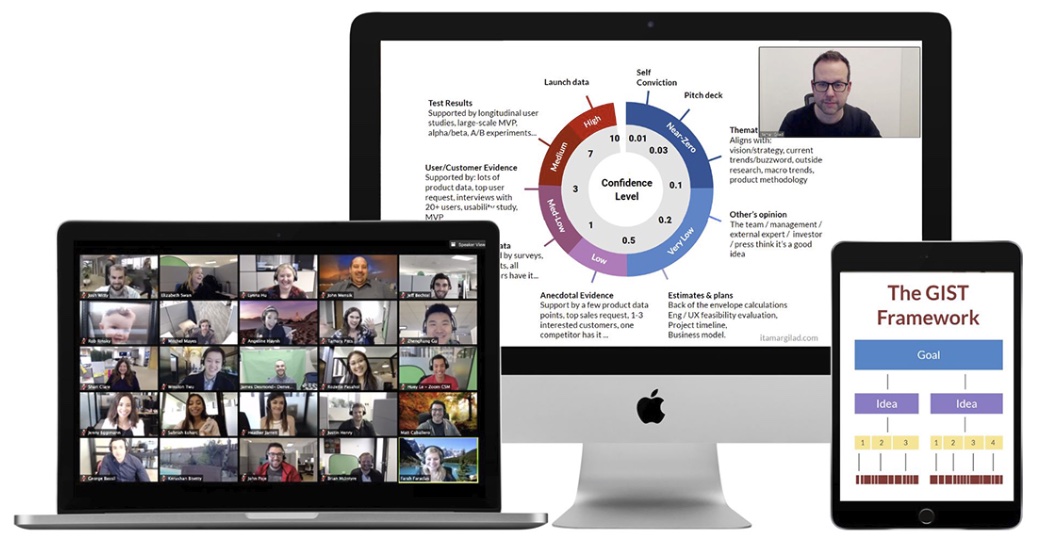
Great blog, Itamar. Offers a great way to showcase where a given company is, and where it can strive to be. Offers tools to measure shifts towards adopting a more Agile mindset.
Thanks for this very nice and documented article.
Another bias with so few people may be the typology of answerers. I suspect people from small modern companies are more willing to answer such form than people from old large companies.